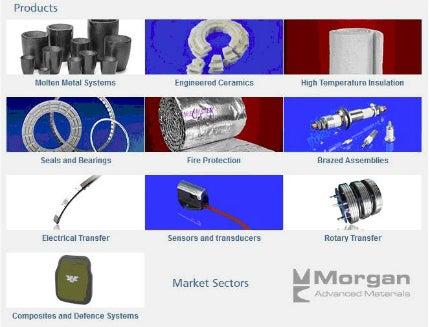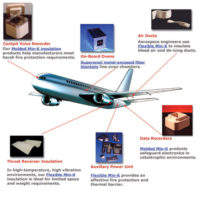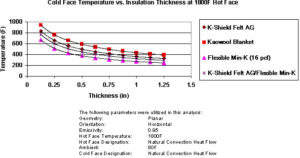Morgan Advanced Materials Thermally Efficient, High-Temperature Aerospace Insulation Systems


Morgan Advanced Materials is an advanced materials technology company that provides highly engineered solutions. We have a global presence with operations in more than 50 countries. From medical instruments, aerospace, power generation and satellite communications, to body armour, trains and fire protection systems, our products are fundamental components or enabling technologies for many of the modern world’s sophisticated products.
Performance
We are able to draw out unique qualities from our materials to enable customers to elevate their products to new levels of performance.
Sustainability
The product we manufacture help customers reduce their energy use and, by lasting longer, reduce waste. They are also key components in many forms of sustainable energy generation.
Efficiency
We design our products to enable our customers to maximize the efficiency of their applications and processes, helping them to achieve optimum results.
Reliability
We ensure that our products perform reliably and consistently even in the most demanding environments, enabling our customers to use them with confidence in the most critical of applications where total reliability is vital.
Thermally efficient insulation
Setting the standard is our Flexible Min-K, one of the most thermally efficient insulations available. Flexible Min-K is used on the engine nacelle, Auxiliary Power Unit (APU) enclosures, and as thermal protection for the struts. On the nacelle, the insulation prevents heat loss from the engine, thus improving internal operating temperature consistency, increasing operating efficiency, and protecting the outer casing. In the APU, Flexible Min-K is utilized as a fire barrier, due to its qualification in a standard 2,000° F, 15-minute performance test.
We are proud to offer an extensive line of thermal insulating products for the aerospace industry.
Quilted insulation material
Flexible Min-K is a quilted microporous insulation offering extremely low thermal conductivity, high-durability and high-temperature (fire) survivability, making it indispensable within applications where space and weight associated with the thermal management systems are a key concern.
Microporous board and shapes
These higher-density, highly machine-able microporous boards and shapes offer sound structural characteristics and very low thermal conductivity.
Endothermic boards and shapes
These boards and shapes include an endothermic component to extend the time required for heat to reach the sensitive internals of flight data recorders in the event of a fire. This patented product line sets the standard for data recorder enclosures and our key customers include Honeywell, Smiths and L-3 Communications.
Insulating tape
Flexible Min-K, fabricated into strips, is designed for use in wrapping pipes or other thermal management challenges. Insulating tapes are designed to provide the dimensional stability and durability essential to applications requiring dependable performance and minimal maintenance.
K-SHIELD Felt AG cermaic fiber mat
K-Shield Felt AG is a high-temperature, low-density, non-woven ceramic fiber mat featuring low thermal conductivity, excellent flexibility, and very low loss on ignition. K-ShieldFelt AG is currently qualified at Boeing under BMS 9-19.
K-SHIELD BF paper cermaic fiber mat
K-Shield BF Paper is an organic free, high temperature, non-woven ceramic fiber mat featuring very low thermal conductivity, and excellent flexibility.
Aero-tech quilts
Aero-Tech Quilts consist of Morgan Thermal Ceramics’ fibrous materials encapsulated and quilted in a range of high temperature textiles. Material type depends on thermal efficiency requirements, allocated space / weight within the application, temperature use requirements, and / or fire survivability demands.
Felt AG composite
This composite of K-Shield Felt AG and Flexible Min-K microporous insulation combines the high-temperature use limit of ceramic fiber felts / papers with the low thermal conductivity of microporous insulation resulting in a lighter weight, lower cost product with improved flexibility and acoustic benefits.
Fiber blankets
Kaowool® Blanket is Morgan Thermal Ceramics’ primary fiber blanket product, and is available in a range of densities and thickness. Other products used within aerospace include Cerafelt® and Cerachrome® Felt, both of which are resin impregnated to improve product strength. Saffil® is a high-temperature alumina fiber product, available through Morgan Thermal Ceramics in both bulk and blanket form, which currently finds use on the Delta II and Delta IV systems.
Saffil is a registered trademark of Saffil Limited.
Products and Services
Video
White Papers
Related Projects

Ionospheric Connection Explorer (ICON) Satellite

Parker Solar Probe Spacecraft

Inmarsat-5 F4 Communications Satellite
Press Release
A state-of-the-art facility which is set to drive global developments in structural ceramic materials and technology has been officially opened by Morgan Advanced Materials.
Read moreMorgan Advanced Materials is set to launch a new ultrasonic transducer for measurement within the residential and industrial gas metering sector, optimising energy efficiency by offering customers greater transparency of energy consumption.
Read moreMorgan Advanced Materials has further enhanced its range of market-leading products for the wind energy sector with the addition of a new brush gear for users of Vestas V52 to V80 series wind turbines.
Read morePete Raby is the new Chief Executive Officer at global materials technology specialist Morgan Advanced Materials.
Read moreMorgan Advanced Materials has further extended its offering to the utilities sector with the addition of a new range of ultra-wide bandwidth, high-sensitivity air coupled ceramic sensors for flow metering.
Read moreMaterials engineering company Morgan Advanced Materials has joined forces with a leading research university to investigate the use of alumina blocks in new generation ultrasonic flow meters.
Read moreMorgan Advanced Materials’ seals and bearings business provides superior quality axial and radial seal components for applications in severe service conditions.
Read moreMorgan Advanced Materials Announces Advances in High-Purity Materials for Semiconductor Applications
Morgan Advanced Materials has announced an expansion in its range of materials grown using chemical vapor deposition (CVD) processes.
Read moreRegional Offices
2102 Old Savannah Road
Augusta
30906
Georgia
United States of America
Quadrant
55-57 High Street
Windsor
SL4 1LP
Berkshire
United Kingdom














